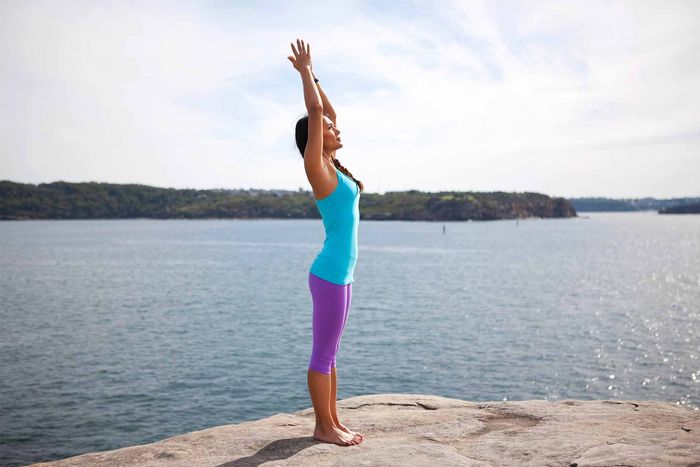How To Do The Upward Salute And What Are Its Benefits : Urdhva Hastasana
Upward Salute or Urdhva Hastasana is a natural way to stretch the whole body,Consciously, or subconsciously, when you roll out of bed every morning, you raise your arms, stretch as your spine arches, and your head hangs at the back. It energizes you after you have had a full night’s sleep. That stretching is what this asana is all about. It’s a simple way to feel rejuvenated! The name comes from the Sanskrit words “urdhva” meaning “upward”, “hasta” meaning “hand”, and “asana” meaning “pose”.
What You Should Know Before You Do The Asana
This asana must be performed on an empty stomach. You must have your meals at least four to six hours before you practice yoga. You must also make sure that your bowels are empty. Those with shoulder or neck injuries should avoid fully raising their arms overhead. Instead, practice Mountain Pose or a gentler arm variation.

How To Do The Urdhva Hastasana : Step-by-Step Instructions
- You must begin by assuming the Tadasana. Stand with your arms at your sides. Then, gently raise them to the ceiling.
- Make sure that your arms are parallel to each other. You can also bring your palms together over your head. While you do this, make sure your shoulders are not hunched. If your palms are apart, then they must face each other. Your arms must be straight at all times such that they are activated all throughout, till your fingertips. Move your gaze upwards.
- Your shoulders must be away from your ears, and your shoulder blades must be pressed firmly on your back.
- Your thighs should be engaged in such a way that they pull the kneecaps up. Straighten your legs, but do not lock your knees. Always remember that a micro-bend in your knees is safer for your joints.
Tips
Keep these tips in mind when practicing the pose:
- Maintain the alignment of Tadasana throughout the pose. Thoroughly review the instructions for Tadasana before practicing Urdhva Hastasana.
- Keep your shoulders over your hips, and your hips in line with your ankles.
- Do not let your lower, front ribs poke forward. Draw them in and slightly down toward your belly. You may need to lower your arms to make this possible. If you do, that’s fine. It is more important to keep the alignment of your spine and ribs than to reach your arms very high.
- Only press your palms together while your arms are overhead if you can keep your arms straight without drawing your shoulders up or letting your ribs poke forward.
- If it’s difficult to straighten your arms when they’re overhead, bring your arms farther apart — shoulder-distance or wider. Stretch from your inner elbows to your palms to straighten the arms, and then extend through your fingertips.
- Beginners can practice the pose backed up against a wall. There will be a slight curve in your lower back, but your heels, buttocks, and shoulders should gently touch the wall. Keep your head away from the wall, with your ears in line with your shoulders.
Beginner’s Tip
To help straighten your raised arms, secure them with shoulder-width loop around your upper arms just above the elbows.
Modifications & Variations
You could intensify your stretch by converting this pose into a backbend. All you need to do is bend your spine backward as if you are leaning over a beach ball. You must let your neck hang back. Eventually, you should be able to take the Wheel Pose.
Benefits Of The Upward Salute
These are some amazing benefits of Urdhva Hastasana.
- It gives the belly a good stretch.
- It helps improve digestion.
- It gives the armpits and the shoulders a good stretch.
- It relieves stress and anxiety.
- It helps enhance body posture.
- It helps increase the capacity of the lungs.
- It improves blood circulation in the body.
- It eases sciatica.
Preparatory Poses
Tadasana
Follow-Up Poses
Padmasana
You can practice Urdhva Hastasana throughout your day, whenever you need a full body stretch! By practicing it often, you’ll gain a better understanding of the alignment and movements of the pose — from which you can gain the confidence you’ll need to move into more advanced poses, like inversions and backbends.




